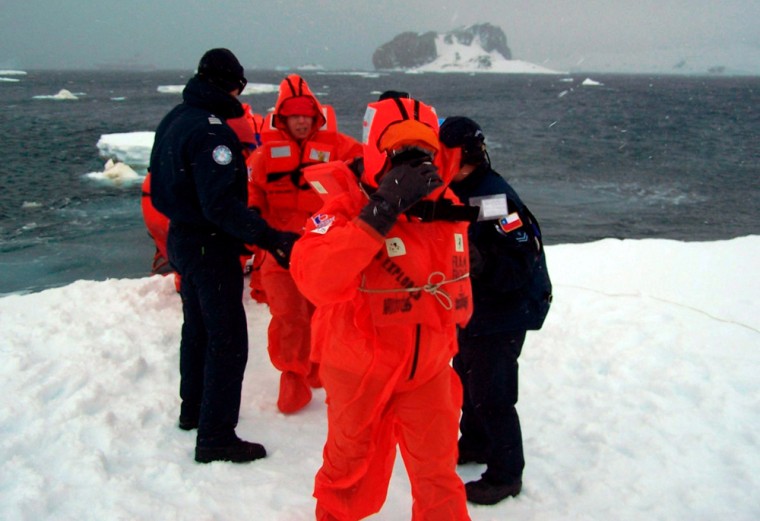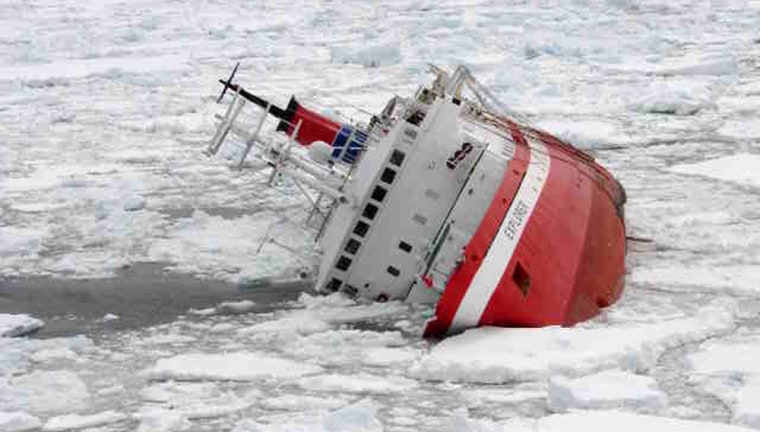A Canadian cruise ship struck submerged ice off Antarctica and began sinking, but all 154 passengers and crew, Americans and Britons among them, took to lifeboats and were plucked to safety by a passing cruise ship.
The Chilean navy said the entire MS Explorer finally slipped beneath the waves Friday evening, about 20 hours after the predawn accident near Antarctica's South Shetland Islands.
No injuries were reported although passengers reportedly endured subfreezing temperatures for several hours as they waited in bobbing lifeboats for a Norwegian liner that took them to a Chilean military base in the region.
The Explorer struck submerged ice and began taking on water through its cracked hull early Friday, authorities said. Susan Hayes of G.A.P. Adventures of Toronto, which owned the vessel, initially described the damage as a "fist-sized hole," but the Argentine navy later said it observed "significant" damage to the hull.
The tour operator said the voyage was inspired by Ernest Shackleton, an adventurer who made repeated forays there in the early 1900s. Shackleton died of a heart attack aboard his ship while trying to circumnavigate the icy continent by sea in 1922.
Throughout the day, Chilean aerial photographs showed the ship listing heavily, its white superstructure and red hull starkly visible against the gray, choppy waters and overcast skies. The navy eventually lost sight of the ship and wreckage indicated it had gone under completely, according to a navy press officer who declined be identified in accordance with department policy.
‘The Explorer is not visible any longer’
"Our units in the area aren't seeing anything," he told The Associated Press by telephone. "The Explorer is not visible any longer."
Hayes said 91 passengers had been aboard, including at least 23 Britons, 17 Dutch, 14 Americans and 10 Canadians. The ship also carried nine expedition staff members and a crew of 54.
The group calmly abandoned ship when the captain's order came and pumps helped keep the ship stable for an orderly evacuation, Hayes said.

Arnvid Hansen, captain of the Norwegian liner Nordnorge, said his ship ferried the passengers and crew to a Chilean air force base on King George Island in Antarctic waters near southernmost South America.
"The rescue operation ran very smoothly," the 54-year-old captain told The Associated Press by shipboard telephone from the Nordnorge.
A U.S. woman said in an e-mail to family members that she witnessed the high-seas drama from aboard the Nordnorge.
"We were a rescue ship," said Jennifer Enders of Covina, Calif., who was traveling with her husband Robert. "It is really scary to see a ship sinking out your porthole. The people were in the water in lifeboats for 4 hours and it is cold outside. We were asked to donate clothes to those coming in from the lifeboats."
She said it was depressing to watch the ship listing "and lifeboats scurrying around collecting the passengers from the Explorer. Our ship stayed until a naval ship arrived."
Authorities said later that all the rescued passengers had disembarked at the King George Island base and were hoping the weather would clear enough to airlift to Chile's southernmost city of Punta Arenas on Saturday.
G.A.P Adventures is a tour company that provides excursions with an environmental focus. The Explorer was on a 19-day circuit of Antarctica and the Falkland Islands letting passengers observe penguins, whales and other wildlife while getting briefings from experts on the region.
Traveling to Antarctica is always risky, Hayes said.
"There is ice in the area. Obviously it's a hazard of the area. But it's highly unusual (that the ship would hit the ice). This has never happened to us," he said.
An Argentine rescue and command center received the first distress call at 12:30 a.m. EST Friday from the Explorer amid reports it was taking on water despite efforts to use onboard pumps, said Capt. Juan Pablo Panichini, an Argentine navy spokesman.
A navy statement said that the captain ordered passengers to abandon ship about 90 minutes after the first call and that passengers and crew boarded eight semi-rigid lifeboats and four life rafts, with the captain leaving the ship later.
In lifeboats in subfreezing temperatures
A Chilean ornithologist identified as Paola Palavecino was quoted in an Argentine media report as saying she and others aboard went into the lifeboats before dawn and endured subfreezing temperatures for a few hours until they were picked up about 6 a.m. EST.
"The ship took on water quickly," she was quoted by the Argentine news agency Diarios y Noticias as telling a local radio station in a call from the Nordnorge.
A commander at Chile's air base on King George island confirmed late Friday that the Nordnorge had arrived in a bay near the base, but said waves and strong winds had prevented the passengers from immediately disembarking.
He said Chilean air force planes, weather permitting, would fly the survivors on Saturday to Punta Arenas at the southernmost tip of Chile.
An Argentine navy statement said the Explorer was about 475 nautical miles southeast of Ushuaia, the southernmost Argentine city and a jumping-off point for cruise ships and supply vessels for Antarctica. Seas were calm and winds light at the time of the accident, officials said.
Last Feb. 1, the Nordnorge evacuated 294 passengers, including 119 Americans, from a sister Norwegian cruise ship, the MS Nordkapp, which ran aground off a remote Antarctic island. The Nordkapp later pulled off the rocks under its own power and authorities said those passengers were never in danger.
